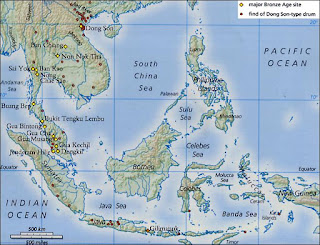 |
| Plain of Jars site in Laos |
For the purposes of this blog, Southeast Asia will be held to comprise the lands of Myanmar, Thailand, Laos, Vietnam, Cambodia, the Philippines, Malaysia, Singapore, Brunei, the archipelago of Indonesia and East Timor. There are strong reasons for including Taiwan and southern China within the remit of this piece, but these will be covered elsewhere I think.
From a linguistic perspective, the mainland of Southeast Asia was probably populated by speakers of Proto-Austroasiatic languages, which would later diverge to form language groups such as the Khmer and Vietic languages. The speakers of Austronesia languages had begun their epic migrations that would see their language family stretch from Madagascar to Easter Island. Other languages such as Tai languages group or the Lolo-Burmese portion of Sino-Tibetan were not yet much spoken in the region, as the speakers of these languages came in later migrations to the region. Agriculture had spread to nearly every part of Southeast Asia and bronze working was well known on the mainland, although it had perhaps not spread out to the island archipelagos of Indonesia and the Philippines just yet.
 |
| Plain of Jars site in Laos |
The Dong Son culture was a Bronze Age culture centred on the Red River Delta in Vietnam. They had used wet-rice agriculture to feed their people. Later Vietnamese chronicles speak of a semi-legendary Van Lang Dynasty that ruled the region around this time and far earlier. It is likely that the Van Lang are legendary, at least around this period. But it is also possible that in the following centuries that there was a kingdom called Van Lang. If this kingdom did exist, it was said to have an important citadel at Cổ Loa, where there is indeed a record of ancient settlement. As I say, I don’t want to credit the legends of the Van Lang too much, but I would not consider them entirely without foundation either.
 |
| Distribution of Dong Son drums |
Around the century of the 800’s BC the Gò Mun culture seems to have come to an end. This was a culture in what is now northern Vietnam and either the people of the Gò Mun culture were conquered or assimilated into the Dong Son culture, or the material goods and cultural patterns of the Dong Son culture were perceived as superior and thus adopted by the Gò Mun culture.
Also around this time, the Xieng Khouang Plateau in Laos saw a trading society. This is interesting as it shows that trading networks were spreading into the interior regions, whereas the Sa Huỳnh and Dong Son appear to have been trading by sea.
Around the century of the 700’s BC wet rice cultivation had spread to the Indonesian Archipelago. Or more accurately, it had spread to certain areas thereof, particularly Java.
 |
| Dong Son drum |
Around the century of the 500's BC ironworking was beginning to be seen in Mandalay in what is now Burma. Iron-working had now begun to spread throughout much of the region, particularly the regions now referred to as Thailand, Laos and Cambodia. It is probable that iron-working was known in what is now the country of Vietnam, but considering that bronze-working was held in such high esteem by the cultures there, it may have delayed the onset of the Iron Age.
In what is now Laos, it is probable that the site known as the Plain of Jars began to be used. The Plain of Jars is an area on the Xieng Khouang Plateau that contains some enigmatic monuments. Great stone jars were placed across the plains. The jars were probably once lidded, but few lids survive. These megaliths, for they are carved out of single large stones, are not easy to date, as stone cannot be carbon-dated. It is suspected that these are connected in some ways with the trade routes through the region, but we cannot tell exactly who built the jars on the Plain of Jars, or why. They are perhaps one of the most fascinating megalithic sites in the world.
And thus the period draws to a close, with the beginning of the Iron Age in Southeast Asia, the long-distance Sa Huỳnh trading network, the elaborate bronze drums for the elites of the Dong Son, and the Plain of Jars for reasons that no one yet knows.
 |
| Dong Son drums |
Some Southeast Asian history from 4000-2000BC
Some Southeast Asian history from 2000-1000BC
Some Southeast Asian history from 1000-500BC
The Plain of Jars
No comments:
Post a Comment